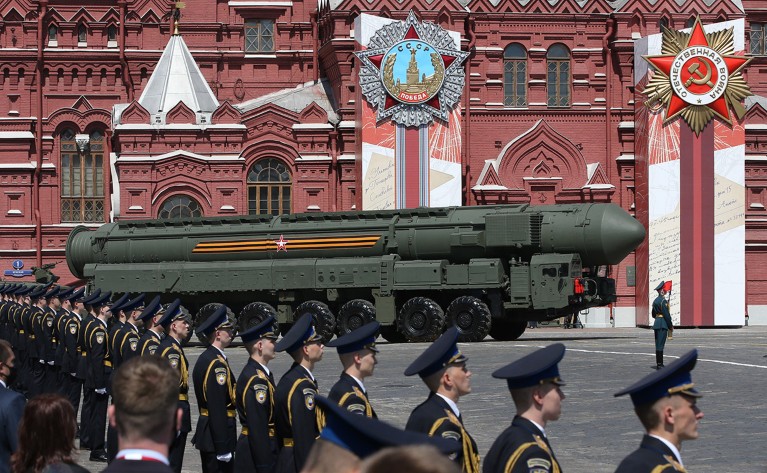
A Russian nuclear missile is paraded in Moscow’s Red Square during a military parade.Credit: Mikhail Svetlov/Getty
The world has lurched a step closer to the prospect of nuclear war, say researchers, after Russia declared last month that it would suspend its participation in its last major nuclear-arms treaty with the United States.
Russian President Vladimir Putin’s announcement will formally end inspections under an agreement known as the New START treaty (Measures for the Further Reduction and Limitation of Strategic Offensive Arms). The inspection programme had allowed scientists on both sides to verify that the other was complying with the agreement. The move comes amid soaring tensions between Russia and the West over the war in Ukraine.
New START limits Russia and the United States to 1,550 strategic warheads each, but has been facing challenges for years. The COVID-19 pandemic forced a pause in weapons inspections, and they have not restarted since Russia invaded Ukraine last year. US US government officials said in January that Russia was in violation of the treaty because it would not allow inspections to resume. However, Russia’s official suspension of the inspections is another blow to international efforts to control nuclear weapons, say experts, who worry that the world’s largest nuclear powers will not be subject to any arms-control obligations once New START expires in three years — or even sooner.
Nature discussed the rising nuclear threat with Matthew Bunn, who tracks nuclear policy at Harvard University in Cambridge, Massachusetts. Bunn participates in one of the last remaining back-channel dialogues between Russian and US scientists, a mechanism that researchers developed during the cold war to foster communication — and avoid conflict. He has spent decades cultivating relationships with Russian scholars, nuclear scientists and military officials, only to see many of those relationships evaporate since the war in Ukraine, which Bunn says has created a level of hostility between the two nuclear superpowers that has not existed since the Cuban Missile Crisis in 1962. The situation is becoming increasingly precarious across the board, he says, but there are still reasons for hope.

Nuclear-policy researcher Matthew Bunn has spent decades cultivating relationships with Russian scholars, nuclear scientists and military officials.Credit: Chip Somodevilla/Getty
What is the danger of Putin suspending Russia’s participation in New START?
It’s another important step undermining the future of arms control. The New START treaty expires in February 2026, and with the war in Ukraine, no talks are under way on any kind of replacement. Now even the New START treaty may fall apart before February 2026, and we may find ourselves for the first time in half a century in a world with no limits on US and Russian nuclear forces. That would increase dangers to all of us.
Back-channel dialogues during the cold war helped to defuse tensions. Are they still happening?
Almost all US–Russian communication is cut off, and many non-government dialogues have been cut off. Russia appears also to have instructed current and retired people involved in its nuclear-weapons complex not to participate in these dialogues, so the kinds of conversation that I used to have regularly with Russian colleagues are just not happening anymore.
However, the national academies of Russia and the United States have continued their nuclear arms-control dialogue, in which I am a participant. We’ve explored a lot of the key issues that would be required to be addressed in the next round of nuclear arms-control negotiations. I won’t say those discussions have been easy, and we have not found it very productive to spend much time talking about who’s right and who’s wrong in the war, but that dialogue is ongoing and both governments have asked us to continue.
How should the United States and other nuclear powers respond to Russia’s decision?
The United States needs to continue to maintain the New START Treaty as much as possible. It needs to get Russia back to the verification table, and I think we should do our best to maintain at least the basic numerical limits of New START, which Russia says it’s also willing to maintain. And we need to find ways to get back to the table not only on arms control, but on military-to-military dialogues and other measures to try to reduce the risk of inadvertently stumbling into a nuclear conflict that no one wants.
Russia is just one country, and New START is just one treaty. What about the rest of the world?
If you look at the nuclear landscape, you have more hostility between the United States and China. You have North Korea with a burgeoning nuclear arsenal, you have India and Pakistan with growing nuclear arsenals and you have Iran, with the collapse of the Iran nuclear deal in 2018, right at the edge of a nuclear-weapons capability. It’s a much darker nuclear picture that it was even a decade ago.
Now, does that mean everybody should run for the hills? No. I think that core deterrence is very strong. The United States and Russia, and the United States and China, have enormous incentives not to end up lobbing nuclear weapons at each other’s homelands. But there’s a lot to do to repair the nuclear order internationally.
Are you hopeful?
I’m worried, but I am one of the last standing optimists. If I had to bet, I would bet that ten years from now, we will have no new nuclear-armed states. Only 5% of the states in the world have nuclear weapons, and that was also true 35 years ago. That’s an amazing public-policy success story, but there is a lot of work to do and a lot of rethinking to do to reduce the nuclear dangers that have been growing in the world in recent years.

